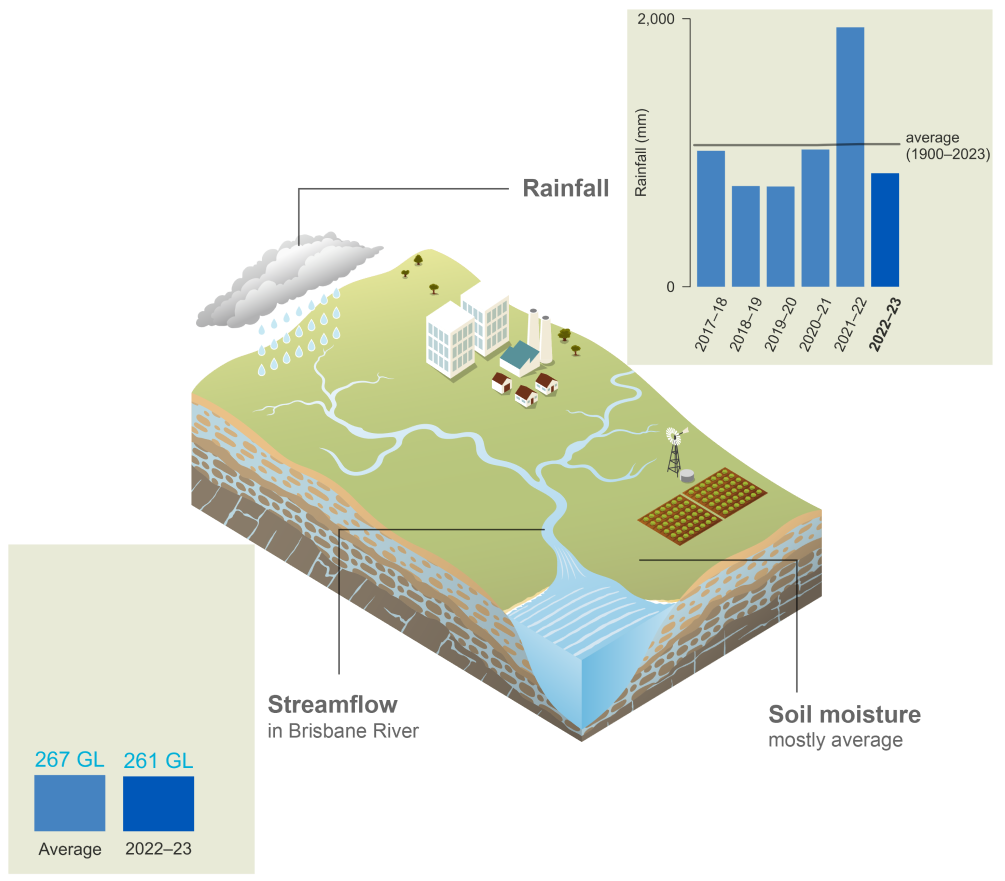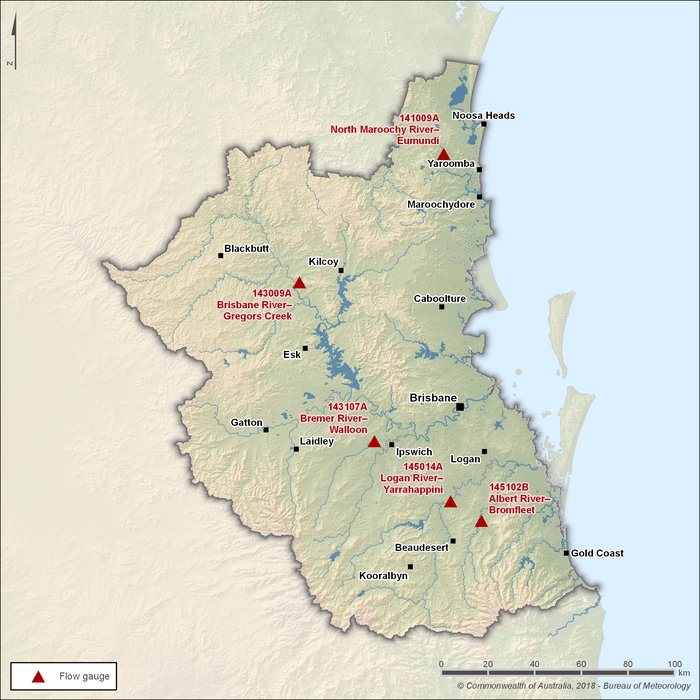South East Queensland: Climate and water
For the water account period 01 July 2022 - 30 June 2023
- Total annual rainfall for the 2022-23 year was below average.
- It was a wet start to the 2022-23 year, with monthly totals above the 90th percentile in mid-winter and early-spring, but rainfall from November was below average for the region.
- Soil moisture in the root zone (0-1m depth) was average with some areas of below average soil moisture, reflecting the year of below average rainfall.
- Total annual flows in the region's major rivers were below average at all sites despite most sites peaking above the 90th percentile during late winter and early spring.

For further information on the region's climate and water conditions during the 2022-23 year scroll down this page or click on the links below:
About the region
- The South East Queensland region has a subtropical climate, characterised by hot and humid summers, and cool to mild winters.
- Although there is no distinctive dry season, higher rainfall totals are more common during the northern tropical wet season (October to April).
- Streamflows in the region's rivers typically reflect the distribution of rainfall throughout the year. Higher streamflows and storage inflows occur during the northern tropical wet season (October to April), while lower streamflows occur during the northern tropical dry season (May to September).
Climate conditions
Rainfall
Figure C1 Annual and monthly rainfall deciles for the South East Queensland region during the 2022-23 year
- Total area-averaged rainfall for the 2022-23 year was 847 mm, 20% below the mean value of 1,063 mm. Rainfall in seven of the last eight years has been below average.
- Persistent rainfall resulted in double the monthly average rainfall for July 2022.
- In September 2022, a third consecutive La Niña event was declared active in the tropical Pacific Ocean (Climate Driver Update). La Niña events can increase the chances of above average rainfall during spring and summer in this region.
- September rainfall was more than twice the monthly average with wettest September totals on record over much of the southern part of the region. In many areas, including the Lake Wivenhoe catchment, rainfall was also well above average through October.
- In contrast, rainfall was below average throughout the rest of the 2022-23 year, particularly during February and June which had around a third of the average monthly rainfall.
- More information on Australia's climate and water over the 2022-23 year can be found at: Financial year climate and water statement 2022-23.
Figure C2 Total monthly rainfall for the South East Queensland region during the 2022-23 year compared with the average and percentiles for the region
- Rainfall was above the 90th percentile for July 2022, September 2022, and October 2022.
- February 2023 was the only month to record rainfall equal to or below the 10th percentile. November 2022, and June 2023 were particularly dry for their respective months, but remained above the 10th percentile.
- Only three months (July 2022, September 2022, and October 2022) recorded above-average rainfall for the 2022-23 year.
Actual evapotranspiration
Figure C3 Annual and monthly actual evapotranspiration deciles for the South East Queensland region during the 2022-23 year
- Total area-averaged actual evapotranspiration for the 2022-23 year was average to above average despite rainfall being below average across the region. This was likely due to a very wet 2021-22 maintaining high water availability into 2022-23.
- This residual landscape moisture combined with mostly high rainfall into mid spring saw above average evapotranspiration for the first half of the 2022-23 year.
- From December onward, with lower rainfall across the region, evapotranspiration was mostly average to below average.
Soil moisture
Figure C4 Annual and monthly soil moisture deciles for the South East Queensland region during the 2022-23 year
- Soil moisture in the root zone (0–1 m depth) for the 2022-23 year was mostly close to average, with areas along the eastern half of the region experiencing below average soil moisture.
- With soils already relatively wet going in to the 2022-23 year, above average July 2022 rainfall resulted in above average soil moisture, particularly in the western half of the region which was very much above average.
- Soil moisture remained predominantly above average through spring following above average rainfall during September and October 2022.
- Reflecting lower than average rainfall in the second half of the 2022-23 year, soil moisture was mostly below average from January, with small areas in the north seeing lowest soil moisture on record from March to June 2023.
- More information on soil moisture distribution across the region is available in the Australian Water Outlook.
Streamflow responses

Figure C5 Key flow gauging stations along the main rivers within the South East
Queensland region
- The five main rivers in the region are the Albert, Brisbane, Logan, Bremer and Maroochy rivers.
- The seasonal flow characteristics of these rivers reflect the rainfall pattern of the region, where most rainfall occurs between November and March.
Figure C6 Total monthly flow for major rivers in the South East Queensland region during the 2022-23 year compared with the average and percentiles
- Total annual flows in the region's major rivers were below average at all sites reflecting below average rainfall during the 2022-23 year. Upstream of Lake Wivenhoe, Brisbane River at Gregors Creek (Station 143009A) had close to average streamflow, the majority of which occured in the first half of 2022-23 year.
- With heavy rainfall events and wet soils generating runoff, streamflows in July 2022 rose above the 90th percentile and remained above the 90th percentile at most sites through to October 2022.
- Although streamflows in this region usually peak in flow during the wet season (November to April), rainfall throughout the 2022-23 summer and autumn was below average, resulting in streamflows also being below average through the second half of the 2022-23 year.









